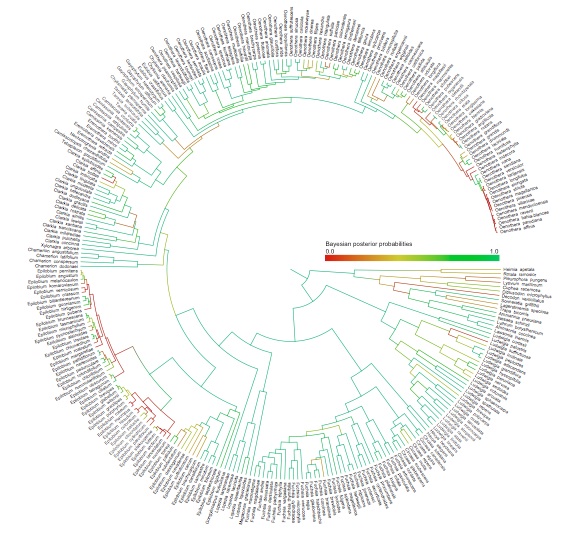IB290
UC Berkeley Grad Seminar in Phylogenetics

IB290: Topics in Phylogenetics
UC Berkeley
- Grad Seminar 460
- Class Number 67082
- Fall, 2017
- Wednesdays 5:15 - 6:45 PM
- 1002 VLSB
- Class website: https://wf8.github.io/IB290/
Instructors
- Carl Rothfels – crothfels@berkeley.edu
- John Huelsenbeck – johnh@berkeley.edu
- Will Freyman – freyman@berkeley.edu
Format
The instructors will lead a series of introductory sessions (lectures) for the first four or five meetings. Subsequent meetings will be student-led. Each student will be responsible for leading at least one session (potentially more, depending on enrollment and interest) on a topic of their choice, in consultation with the instructors. That student will be responsible for developing an annotated bibliography of the important papers on the topic, including both “classics” and the most recent works, for selecting two or so of the papers for the class to read, and for preparing a short (15min) presentation on the topic. The remainder of the session will be devoted to discussion.
Course Texts
There are no formal texts required for this seminar, but participants are encouraged to consult Tree Thinking: An Introduction to Phylogenetic Biology (Baum & Smith 2012) and also Inferring Phylogenies (Felsenstein 2004).
Useful Info
Here are some useful links on statistics and phylogenetic software: https://wf8.github.io/IB290/useful
Possible Topics for Student Led Discussions
Please consult an instructor before settling on a topic:
modeling migration/hybridization/introgression (phylogenetic networks); state-dependent diversification models; fossil data (e.g. fossilized-birth-death process/tip dating vs node calibrations); modeling gene duplication and loss; polymorphism-aware (PoMo) models; covarion/hidden state models; model testing (e.g. Bayes factors, AIC); model adequacy (e.g. posterior predictive tests); demographic inference (e.g., inferring population size changes through time); the multispecies coalescent, genetrees/species tree; the BAMM controversy; divergence time dating; inferring selection from sequence alignments; alignment inference (alignment-phylogeny co-inference?); community phylogenetics; spatial phylogenetics; inferring phylogenies from morphological data; heterogeneous models, e.g., non-stationary base frequencies; ancestral state reconstruction; phylogenomics (strengths, pitfalls?); inferring correlated evolution of traits; assessing support; hypothesis testing of relationships; reconstructing morphological evolution on a phylogeny; ABC approaches; hidden Markov models; mixture models; species delimitation; microbial community analysis; quartet-based methods (e.g. SVDquartets); etc; etc;
Schedule:
Our first meeting will be on Wednesday, August 30.
August 30: Introductions
Who are we, and want to do we want to get out of this seminar?
- Outline of the course
- Outline of “phylogenetics”, i.e., introduction to trees—what is a phylogeny?—and tree thinking—what does this tree say?
- Discussion of topics to select for future class sessions
- Reading: chapters 1, 2, and 3 of Tree Thinking
- Slides: Rothfels Intro Slides
September 6: Introduction to probability theory
Introduction to probability, estimation, and inference:
- Maximum likelihood
- Bayesian estimation
- MCMC
- Reading: Coin Tossing - Diaconis et al 2007
September 13: Introduction to tree inference and Markov models of character change
Introduction to the application of Markov models to tree inference (Part 1):
- What is a Markov model?
- Properties and uses of Markov models
- Pruning algorithm
- Slides: Huelsenbeck Likelihood Phylo Slides
September 20: Introduction to tree inference and Markov models of character change
Introduction to the application of Markov models to tree inference (Part 2):
- More on Markov models
- Substition models
- Slides: Huelsenbeck Likelihood Phylo Slides
September 27: Introduction to “tree models” and their uses
Introduction to models of tree shape, topology, and branch lengths:
- Uniform tree topologies
- Coalescent trees
- Birth-death processes and their application to:
- Divergence time estimation
- Diversification rate estimation
- Slides: Freyman Coalescent & Birth-Death Slides
October 4: Phylogenetics potpourri – recap and misc. stuff that we didn’t cover yet
Phylogenetics potpourri:
- alignment
- MCMC
- bootstrapping
- gene trees versus species tree
- Slides: Rothfels Phylo Potpourri
October 11: Inferring hybridization, reticulation, and inosculation
Prahlada Papper & Virginia Tartaglio
- Pease, J.B., Haak, D.C., Hahn, M.W., & Moyle, L.C. 2016. Phylogenomics reveals three sources of adaptive variation during a rapid radiation. PLoS Biology, 14(2), e1002379.
- Wen, D., Yu, Y., & Nakhleh, L. 2016. Bayesian inference of reticulate phylogenies under the multispecies network coalescent. PLoS Genetics, 12(5), e1006006.
- Prahlada and Virginia’s annotated bibliography
October 18: Inferring correlated continuous trait evolution
Emily King & Richelle Tanner
- Khabbazian, M., Kriebel, R., Rohe, K., & Ané, C. (2016). Fast and accurate detection of evolutionary shifts in Ornstein–Uhlenbeck models. Methods in Ecology and Evolution, 7(7), 811-824.
- Emily and Richelle’s annotated bibliography
October 25: The fossilized birth-death process
Daniel Latorre
- Heath, T.A., Huelsenbeck, J.P. & Stadler, T. (2014). The fossilized birth-death process for coherent calibration of divergence time estimates. PNAS
- annotated bibliography
November 1: Evolution under the threshold model
Joyce Chery & Will Iles
November 8: Historical biogeographic models
Jun Ying Lim and Isaac Marck
November 15: The Coalescent
Carrie Tribble and Gabriel Damasco
November 22: NO CLASS
November 29: State-dependent speciation and extinction models
Jesus Martinez-Gomez and Mick Song
December 6: Inferring selection
Betsabe Castro Escobar and Jenna Baughman